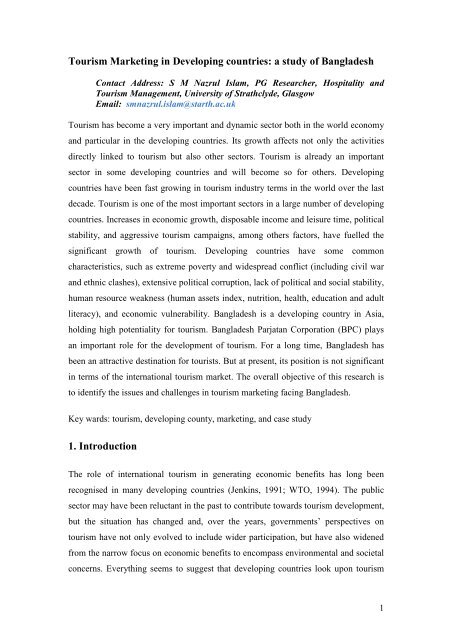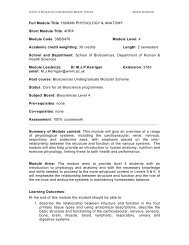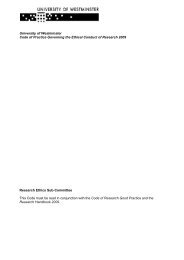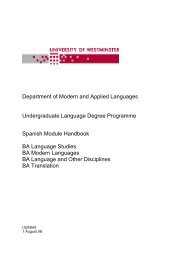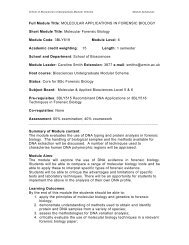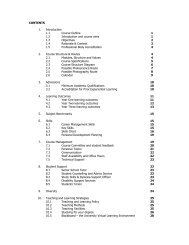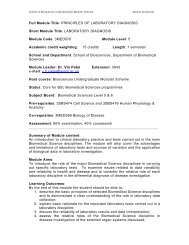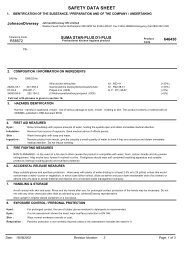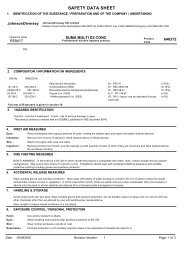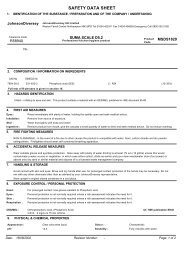Tourism Marketing in Developing countries: a study of ... - FBA | AIUB
Tourism Marketing in Developing countries: a study of ... - FBA | AIUB
Tourism Marketing in Developing countries: a study of ... - FBA | AIUB
- No tags were found...
Create successful ePaper yourself
Turn your PDF publications into a flip-book with our unique Google optimized e-Paper software.
<strong>Tourism</strong> <strong>Market<strong>in</strong>g</strong> <strong>in</strong> Develop<strong>in</strong>g <strong>countries</strong>: a <strong>study</strong> <strong>of</strong> BangladeshContact Address: S M Nazrul Islam, PG Researcher, Hospitality and<strong>Tourism</strong> Management, University <strong>of</strong> Strathclyde, GlasgowEmail: smnazrul.islam@starth.ac.uk<strong>Tourism</strong> has become a very important and dynamic sector both <strong>in</strong> the world economyand particular <strong>in</strong> the develop<strong>in</strong>g <strong>countries</strong>. Its growth affects not only the activitiesdirectly l<strong>in</strong>ked to tourism but also other sectors. <strong>Tourism</strong> is already an importantsector <strong>in</strong> some develop<strong>in</strong>g <strong>countries</strong> and will become so for others. Develop<strong>in</strong>g<strong>countries</strong> have been fast grow<strong>in</strong>g <strong>in</strong> tourism <strong>in</strong>dustry terms <strong>in</strong> the world over the lastdecade. <strong>Tourism</strong> is one <strong>of</strong> the most important sectors <strong>in</strong> a large number <strong>of</strong> develop<strong>in</strong>g<strong>countries</strong>. Increases <strong>in</strong> economic growth, disposable <strong>in</strong>come and leisure time, politicalstability, and aggressive tourism campaigns, among others factors, have fuelled thesignificant growth <strong>of</strong> tourism. Develop<strong>in</strong>g <strong>countries</strong> have some commoncharacteristics, such as extreme poverty and widespread conflict (<strong>in</strong>clud<strong>in</strong>g civil warand ethnic clashes), extensive political corruption, lack <strong>of</strong> political and social stability,human resource weakness (human assets <strong>in</strong>dex, nutrition, health, education and adultliteracy), and economic vulnerability. Bangladesh is a develop<strong>in</strong>g country <strong>in</strong> Asia,hold<strong>in</strong>g high potentiality for tourism. Bangladesh Parjatan Corporation (BPC) playsan important role for the development <strong>of</strong> tourism. For a long time, Bangladesh hasbeen an attractive dest<strong>in</strong>ation for tourists. But at present, its position is not significant<strong>in</strong> terms <strong>of</strong> the <strong>in</strong>ternational tourism market. The overall objective <strong>of</strong> this research isto identify the issues and challenges <strong>in</strong> tourism market<strong>in</strong>g fac<strong>in</strong>g Bangladesh.Key wards: tourism, develop<strong>in</strong>g county, market<strong>in</strong>g, and case <strong>study</strong>1. IntroductionThe role <strong>of</strong> <strong>in</strong>ternational tourism <strong>in</strong> generat<strong>in</strong>g economic benefits has long beenrecognised <strong>in</strong> many develop<strong>in</strong>g <strong>countries</strong> (Jenk<strong>in</strong>s, 1991; WTO, 1994). The publicsector may have been reluctant <strong>in</strong> the past to contribute towards tourism development,but the situation has changed and, over the years, governments’ perspectives ontourism have not only evolved to <strong>in</strong>clude wider participation, but have also widenedfrom the narrow focus on economic benefits to encompass environmental and societalconcerns. Everyth<strong>in</strong>g seems to suggest that develop<strong>in</strong>g <strong>countries</strong> look upon tourism1
consumption as manna from heaven that can provide a solution to all their foreignexchange difficulties (Erbes, 1973: p-1). This description <strong>of</strong> tourism as ‘manna fromhaven’ has ga<strong>in</strong>ed some support, <strong>in</strong> part because tourism is a highly visible activity.Although tourism development results <strong>in</strong> the provision <strong>of</strong> facilities and services, thereare, however, <strong>in</strong>stances when these facilities are not accessible to local residents,particularly if tourism development <strong>in</strong>volves the creation <strong>of</strong> tourism enclaves. In thelast two decades <strong>in</strong> particular tourism has developed, especially <strong>in</strong> develop<strong>in</strong>g<strong>countries</strong> by their <strong>in</strong>tegrated tourism plann<strong>in</strong>g (Buhalis, 1999; Butler, 2002; Vanhove,2005). The specific research objectives <strong>of</strong> this <strong>study</strong> are:1. To identify development trends <strong>in</strong> Bangladesh tourism2. To evaluate the effectiveness <strong>of</strong> tourism market<strong>in</strong>g Bangladesh3. To analyse issues <strong>in</strong> tourism market<strong>in</strong>g <strong>in</strong> Bangladesh; and4. To identify potential strategies that can contribute to <strong>in</strong>creas<strong>in</strong>g the competitiveness<strong>of</strong> Bangladesh tourism.To conduct the research, a conceptual framework from a literature review was createdand implemented us<strong>in</strong>g <strong>of</strong> a particular research methodology and methods.2. Def<strong>in</strong>ition, concept, mean<strong>in</strong>g, and characteristics <strong>of</strong>develop<strong>in</strong>g <strong>countries</strong>The terms ‘the third world’, ‘underdeveloped <strong>countries</strong>’, ‘develop<strong>in</strong>g <strong>countries</strong>’, ‘poor<strong>countries</strong>’, the South’ and ‘less-developed <strong>countries</strong> (LDC’s)’ are mostly used<strong>in</strong>terchangeably (Tosun and Jenk<strong>in</strong>s, 1998). However, it is not an easy task to def<strong>in</strong>eprecisely what is meant by these terms as McQueen (2002). Buchanan (1971, p.20,quot<strong>in</strong>g New Left review, 1963, p. 4) describes ‘the develop<strong>in</strong>g country is a universe<strong>of</strong> radical scarcity. Def<strong>in</strong><strong>in</strong>g and determ<strong>in</strong><strong>in</strong>g every dimension <strong>of</strong> men’s relationshipto each other… the <strong>in</strong>adequacy means <strong>of</strong> livelihood is the first and dist<strong>in</strong>guish<strong>in</strong>g truth<strong>of</strong> this area’. In order to give a more clear mean<strong>in</strong>g <strong>of</strong> the term, it is worth quot<strong>in</strong>gTodaro (2000) at some length: The 143 African, Asian and Lat<strong>in</strong> American member2
<strong>countries</strong> <strong>of</strong> the United Nations <strong>of</strong>ten collectively refer to themselves as the ‘ThirdWorld’ or ‘develop<strong>in</strong>g <strong>countries</strong>’.Develop<strong>in</strong>g Countries, third World <strong>countries</strong>, <strong>in</strong>dustrialis<strong>in</strong>g <strong>countries</strong>,underdeveloped <strong>countries</strong>, and less developed <strong>countries</strong> are <strong>countries</strong> which,accord<strong>in</strong>g to the United Nations exhibit the lowest <strong>in</strong>dicators <strong>of</strong> socioeconomicdevelopment, with the lowest human development rat<strong>in</strong>gs <strong>of</strong> all <strong>countries</strong> <strong>in</strong> theworld. The World Bank (2009) classified develop<strong>in</strong>g <strong>countries</strong> as those hav<strong>in</strong>g percapita <strong>in</strong>come <strong>of</strong> less US$ 2200. Another concept <strong>of</strong> develop<strong>in</strong>g is that they have ahigh level <strong>of</strong> illiteracy; Afghanistan, Pakistan, Bangladesh, India, and Sudan aretypical examples.Accord<strong>in</strong>g to the United Nations (2009), 120 <strong>countries</strong> are described as develop<strong>in</strong>g<strong>countries</strong>, and they comprise less than 20% <strong>of</strong> the world’s total GNP. Pearce (1994)suggests that all those nations out side <strong>of</strong> Europe, North America, Japan and Australiahave to be considered as develop<strong>in</strong>g <strong>countries</strong>. Most develop<strong>in</strong>g <strong>countries</strong> are located<strong>in</strong> Sub-Saharan Africa, Asia, Lat<strong>in</strong> America, Pacific and Caribbean regions <strong>of</strong> theworld. Some <strong>of</strong> these <strong>countries</strong> have fasted development rates. However, there arealso <strong>countries</strong> such as India, Ch<strong>in</strong>a, Bangladesh, Nepal, and Ethiopia that are verypoor. Thus the term ‘develop<strong>in</strong>g <strong>countries</strong>’ is a very broad concept. United Nationsreview <strong>in</strong> 2009, and def<strong>in</strong>ed by the UN that develop<strong>in</strong>g <strong>countries</strong> as <strong>countries</strong> meet<strong>in</strong>gtheir criteria, one <strong>of</strong> which was a three-year average estimate <strong>of</strong> gross national <strong>in</strong>come(GNI) per capita <strong>of</strong> less than US $950. Accord<strong>in</strong>g to the World Bank (2009) worldeconomies are classified economies based on GNI per capita which is calculated us<strong>in</strong>gthe World Bank Atlas method. The groups are: low <strong>in</strong>come, $935 or less; lowermiddle <strong>in</strong>come, $936 - $3,705; upper middle <strong>in</strong>come, $3,706 - $11,455, and high<strong>in</strong>come, $11,456 or more (for <strong>countries</strong> list see the appendix 2-I ). For example, percapita <strong>in</strong>come <strong>of</strong> develop<strong>in</strong>g <strong>countries</strong> <strong>in</strong> year 2007-08 accord<strong>in</strong>g to the World Bank(WB), International Monetary Fund (IMF) and Central Intelligence Agency (CIA)report as <strong>in</strong> February, 2009, such as, Pakistan $1,085 (WB); Kenya USD $680 (IMF);Afghanistan, US$457 (IMF); Ethiopia US$317 (IMF); India, 1078 (CIA); NepalUS$428 (IMF); Nigeria US$401; Sri-Lanka US$2099 (IMF); Vietnam US$1055;Burma US$287 (CIA); Cambodia US$760 (CIA); Haiti US$793, Mali US$712(CIA); Zimbabwe US$401; and Bangladesh US$6903
The least developed <strong>countries</strong> (LDCs) are a group <strong>of</strong> <strong>countries</strong> that have beenidentified by the United Nations (2008) as "least developed" <strong>in</strong> terms <strong>of</strong> their lowgross national <strong>in</strong>come (GNI), their weak human assets and their high degree <strong>of</strong>economic vulnerability. The term Least Developed Countries (LDCs) describes theworld's poorest <strong>countries</strong> with follow<strong>in</strong>g 3 criteria, such criteria are:i. Low-<strong>in</strong>come criterion: based on a three-year average estimate <strong>of</strong> the grossnational <strong>in</strong>come (GNI) per capita (under $750 for <strong>in</strong>clusion, above $900 forgraduation);ii. Human resource weakness criterion: <strong>in</strong>volv<strong>in</strong>g a composite human assets<strong>in</strong>dex (HAI) based on <strong>in</strong>dicators <strong>of</strong>: (a) nutrition; (b) health; (c) education; and (d)adult literacy; andiii. Economic vulnerability criterion: based on <strong>in</strong>dicators <strong>of</strong> the <strong>in</strong>stability <strong>of</strong>agricultural production; the <strong>in</strong>stability <strong>of</strong> exports <strong>of</strong> goods and services; the economicimportance <strong>of</strong> non-traditional activities (share <strong>of</strong> manufactur<strong>in</strong>g and modern services<strong>in</strong> GDP); merchandise export concentration; and the handicap <strong>of</strong> economic smallness.Therefore, India, Bangladesh, and Pakistan have the common economic features <strong>of</strong>develop<strong>in</strong>g <strong>countries</strong> permit us to view them <strong>in</strong> a broadly similar framework. Basedon common characteristics develop<strong>in</strong>g <strong>countries</strong> can be classified <strong>in</strong>to six categories:i) low standard levels <strong>of</strong> liv<strong>in</strong>g; ii) low <strong>in</strong>comes, <strong>in</strong>equality, poor health, and<strong>in</strong>adequate education; iii) low levels <strong>of</strong> productivity; iv) high rates <strong>of</strong> populationgrowth and dependency burdens, substantial dependence on agricultural productionand primary-products exports; v) prevalence <strong>of</strong> imperfect markets and limited<strong>in</strong>formation; and vi) dependence and vulnerability <strong>in</strong> <strong>in</strong>ternational relations (Todaro,2000; World Bank, 2009)Immediately after liberation, the government <strong>of</strong> Bangladesh set up the BangladeshParjatan Sangstha (Bangladesh <strong>Tourism</strong> Organisation), with a view to develop<strong>in</strong>g thetourist <strong>in</strong>dustry <strong>in</strong> the country (Hasan, 2007). The organisation was restructured <strong>in</strong>toBangladesh Parjatan Corporation (BPC) <strong>in</strong> 1973. The corporation drew up a five-yearplan with<strong>in</strong> the framework <strong>of</strong> the first Five-Year Plan (1973-78) for economic andsocial development <strong>of</strong> the country to provide essential facilities and to develop natural4
attractions for <strong>in</strong>creas<strong>in</strong>g the <strong>in</strong>flow <strong>of</strong> tourists and mak<strong>in</strong>g their stay <strong>in</strong> the countryenterta<strong>in</strong><strong>in</strong>g. The second, third, and fourth five-year plans and two year plans were<strong>in</strong>tended to implement by the past Bangladesh governments to develop tourism sectorbut these plans have not been implemented (BPC, 2007) properly by the governmentdue to m<strong>in</strong>isterial legacy problems (Islam, 2007; BTO, 2005). For example, if agovernment has to power down before implement<strong>in</strong>g a tourism development plan, thenext ideal government’s priority should focus on complet<strong>in</strong>g such partially completedprojects first, but <strong>in</strong> reality, they are <strong>in</strong>terested to f<strong>in</strong>d faults with such projects morethan prob<strong>in</strong>g the positive aspects, and <strong>in</strong>tent to formulate a new one to developBangladesh tourism. As a result some <strong>of</strong> the partially completed projects are let outforever. Consequently, this dreadful trend is only wast<strong>in</strong>g time and money hardlydevelop<strong>in</strong>g this sector. (Alim, 2007).<strong>Tourism</strong> <strong>in</strong> its modern sense is a relatively recent phenomenon, and it began <strong>in</strong> thepresent Bangladesh area only dur<strong>in</strong>g the 1960s. Tourists from abroad came to see andenjoy the beaches, the scenic beauty <strong>of</strong> the landscape covered with lavish greens andthe web <strong>of</strong> rivers, tribal culture, religious rituals, historical places, forests, wild lifeand hill resorts (Hasan, 2006).3. Geographical characteristics <strong>of</strong> BangladeshBangladesh is a develop<strong>in</strong>g country <strong>in</strong> South Asia, located between 20°34c to 26°38cnorth latitude and 88°01c to 92°42c east longitude, with an area <strong>of</strong> 147,570 square kmand a population <strong>of</strong> 140 million. It is bordered on the west, north, and east by India,on the southeast by Myanmar, and the Bay <strong>of</strong> Bengal to the south (Environment andBangladesh, undated). Though it is a small country, it has many diverse attractions fornature lovers as well as be<strong>in</strong>g rich <strong>in</strong> culture and heritage. The territorial waters <strong>of</strong>Bangladesh extend 12 nautical miles, and the exclusive economic zone <strong>of</strong> the countryis 200 nautical miles. There is a large marshy jungle coastl<strong>in</strong>e on the Bay <strong>of</strong> Bengalpopularly known as the Sundarbans - one <strong>of</strong> the largest mangrove forests <strong>in</strong> the world,the home <strong>of</strong> the Royal Bengal Tiger. Bangladesh is located <strong>in</strong> the Ganges delta whichis densely populated and it is formed by the confluence <strong>of</strong> the Ganges (Padma),Brahmaputra (Jomuna), and Meghna rivers and their tributaries as they flow downfrom the Himalayas, creat<strong>in</strong>g the largest river<strong>in</strong>e delta <strong>in</strong> the world. To the south is a5
highly irregular deltaic coastl<strong>in</strong>e <strong>of</strong> about 600 km, fissured by many rivers andstreams flow<strong>in</strong>g <strong>in</strong>to the Bay <strong>of</strong> Bengal.4. Development and Role <strong>of</strong> <strong>Tourism</strong> market<strong>in</strong>g Organisation <strong>in</strong>BangladeshDur<strong>in</strong>g the Pakistan period <strong>of</strong> rule, there was a tourism department (later called<strong>Tourism</strong> Cell) with an <strong>of</strong>fice <strong>in</strong> West Pakistan. This department was assignedpromotion, development and regulation <strong>of</strong> the tourism sector <strong>in</strong> Pakistan. A privatesector corporation came <strong>in</strong>to operation at the end <strong>of</strong> 1970. After <strong>in</strong>dependence, thesocio-economic and political climate prevail<strong>in</strong>g <strong>in</strong> the country was not encourag<strong>in</strong>gfor the private sector to participate <strong>in</strong> economic activities <strong>of</strong> wider magnitude.Therefore, it became imperative for the government to come forward by promotetourism <strong>in</strong> Bangladesh (Talukder, 1984). Soon after the <strong>in</strong>dependence <strong>of</strong> Bangladesh,the government <strong>of</strong> the newborn state realised the importance <strong>of</strong> tourism <strong>in</strong> itseconomic and social life. Therefore, the government decided to reorganise the tourismsector (M<strong>in</strong>istry <strong>of</strong> Civil Aviation and <strong>Tourism</strong>, 2004) by comb<strong>in</strong><strong>in</strong>g both the tourismdepartment and the private corporation <strong>in</strong>to one organisation, br<strong>in</strong>g<strong>in</strong>g it undergovernment responsibility for better coord<strong>in</strong>ation, promotion, development andmarket<strong>in</strong>g (Hossa<strong>in</strong>, 2006). Consequently, the government established the National<strong>Tourism</strong> Organisation (NTO) <strong>in</strong> the name <strong>of</strong> Bangladesh Parjatan Corporation underPresidential Order No. 143, declared <strong>in</strong> November 27, 1972. BPC began <strong>in</strong> January1973 with limited assets <strong>of</strong> the former “Pakistan <strong>Tourism</strong> Corporation” and TK.10million ($US147, 059) sanctioned by the government. The Corporation was entrustedwith the dual responsibility <strong>of</strong> develop<strong>in</strong>g tourism <strong>in</strong>frastructure and promot<strong>in</strong>gBangladesh as a tourist dest<strong>in</strong>ation. Other responsibilities <strong>of</strong> the Corporation <strong>in</strong>cludedregulation and operation <strong>of</strong> tourism activities <strong>in</strong> the country. Thus, BangladeshParjatan Corporation came <strong>in</strong>to be<strong>in</strong>g as the NTO <strong>in</strong> Bangladesh (M<strong>in</strong>istry <strong>of</strong> CivilAviation and <strong>Tourism</strong>, 2004). As such, the structure <strong>of</strong> the tourism sector <strong>in</strong>Bangladesh is predom<strong>in</strong>antly managed by the public sector. The public sector hasplayed a pioneer<strong>in</strong>g role <strong>in</strong> the development and promotion <strong>of</strong> tourism <strong>in</strong> the country.Government <strong>in</strong>volvement <strong>in</strong> the tourism sector is channelled through BPC (Hossa<strong>in</strong>,2006), which is under the M<strong>in</strong>istry <strong>of</strong> Civil Aviation and <strong>Tourism</strong>. As a semiautonomousorganisation it enjoys wide power and authority, <strong>in</strong>clud<strong>in</strong>g the right to6
acquire and dispose <strong>of</strong> property; construct and run hotels, restaurants and othertourists facilities; operate duty free shop (DFSs), transportation and car rental;establish tra<strong>in</strong><strong>in</strong>g <strong>in</strong>stitutes; and <strong>in</strong>vest its funds as it deems proper (Rahman, 2004).Due to neglect by successive governments, BPC totally failed to achieve theobjectives for which it was created. Had there been no private sector tour operators <strong>in</strong>the country th<strong>in</strong>gs would have been even more precarious (Hossa<strong>in</strong>, 2006; TheIndependent, 2003). They have kept the hope <strong>of</strong> tourism alive, almost withoutgovernment support. Private sector <strong>in</strong>volvement <strong>in</strong> tourism <strong>in</strong> Bangladesh is still notadequate however, and the Bangladesh government has taken remedial measures toencourag<strong>in</strong>g the private sector to play a positive role <strong>in</strong> the development anddiversification <strong>of</strong> tourist facilities to promote domestic and <strong>in</strong>ternational tourism <strong>in</strong> thecountry (Rahman, 2004). A large proportion <strong>of</strong> <strong>in</strong>vestments have been made <strong>in</strong> hotelbus<strong>in</strong>esses and tour operations. Private sector <strong>in</strong>vestors now are as show<strong>in</strong>g a keen<strong>in</strong>terest to participate <strong>in</strong> the tourism sector (Rahman, 2005; Hossa<strong>in</strong>, 2006). Touroperators have a significant role to play <strong>in</strong> tourism bus<strong>in</strong>ess. Over 40 private touroperators have already been engaged <strong>in</strong> tourism market<strong>in</strong>g <strong>in</strong> Bangladesh. Some <strong>of</strong>them conduct only domestic (<strong>in</strong>bound) tours while others <strong>of</strong>fer both domestic andoutbound tours (Bangladesh Monitor, 2007). Thirty two such private tour operatorsare members <strong>of</strong> an association named “Tours Operator Association <strong>of</strong> Bangladesh(TOAB)”, formed to carry out their activities more efficiently, to lobby the BPC andthe government for the realization <strong>of</strong> justified rights (Siddiqi, 2006), and to promotethe country’s tourism together.Travel agencies <strong>in</strong> both the dest<strong>in</strong>ation and the tourist generat<strong>in</strong>g <strong>countries</strong> also playimportant roles <strong>in</strong> the promotion and development <strong>of</strong> tourism <strong>in</strong> a country (Hossa<strong>in</strong>,2006). There are 235 travel agencies <strong>in</strong> Bangladesh; most <strong>of</strong> them are members <strong>of</strong> theAssociation <strong>of</strong> Travel Agents <strong>of</strong> Bangladesh (ATAB) (M<strong>in</strong>istry <strong>of</strong> Civil Aviation and<strong>Tourism</strong>, 2006). These travel agencies are licensed by the Registration Authorityunder the M<strong>in</strong>istry <strong>of</strong> Civil Aviation and <strong>Tourism</strong> and controlled by the sameauthority under the Travel Agencies Registration and control ord<strong>in</strong>ance <strong>of</strong> 1977,which says that the travel agencies are <strong>in</strong>volve themselves <strong>in</strong> travel arrangements only(Jobber, 1986; Hossa<strong>in</strong>, 2006).7
5. Bangladesh tourism market<strong>in</strong>g products and tourist attractionsThe world th<strong>in</strong>ks <strong>of</strong> Bangladesh as poor, flood-ravaged, and more <strong>of</strong> a disaster zonethan a travel dest<strong>in</strong>ation. In some respects, the world is right but hid<strong>in</strong>g beh<strong>in</strong>d theseimages is a country with a rich history, a strange beauty, and some <strong>in</strong>terest<strong>in</strong>gattractions but it is not, however, a dest<strong>in</strong>ation for everyone (Roam<strong>in</strong>g aroundBangladesh, undated) (Hossa<strong>in</strong>, 2006). Bangladesh is a country with rich traditions,natural beauty, beaches, forests, lakes, hills, wild lives, archaeological attractions,monuments, handicrafts, sanctuaries, religious festivals, cultural heritage, tribalculture and architecture, <strong>in</strong>credible greenery, mighty rivers and attractive river cruises,sunny beaches, colourful tribal life and attractive cultural functions that <strong>of</strong>fer greattourist attractions (Haque, 2005; Hossa<strong>in</strong> and Nazm<strong>in</strong>, 2006). <strong>Tourism</strong> <strong>in</strong>volvestravell<strong>in</strong>g for pleasure, enjoy and education. It is also a bus<strong>in</strong>ess <strong>of</strong> attract<strong>in</strong>g touristsand provid<strong>in</strong>g for their accommodation and enterta<strong>in</strong>ment. In many <strong>countries</strong>, tourismis an <strong>in</strong>dustry for earn<strong>in</strong>g revenue and foreign exchange (Hossa<strong>in</strong>, 2007). The manybus<strong>in</strong>esses that grow concurrently with the development <strong>of</strong> tourism <strong>in</strong>clude airl<strong>in</strong>es,shipp<strong>in</strong>g, hotels and restaurants, f<strong>in</strong>ance companies, tour operators, travel agents, carrental firms, caterers and retail establishments and together, they contributesignificantly to the overall development <strong>of</strong> a country's economy and to its culturaldiversification and adaptation (Islam, 2009).The Moorish traveller Ibn Batuta who visited Bengal <strong>in</strong> the fourteenth centurydescribed Bengal as the wealthiest and cheapest land <strong>of</strong> the world and stated that itwas known as ‘a hell full <strong>of</strong> bounties’ In the seventeenth century French travellerFrancois Bernie observed and stated “Egypt has been represented <strong>in</strong> every age as thef<strong>in</strong>est and most fruitful country <strong>in</strong> the world, and even our modern writers deny thatthere is any other land <strong>of</strong> peculiarly favoured by nature; but the knowledge I haveacquired <strong>of</strong> Bengal dur<strong>in</strong>g two visits paid to that k<strong>in</strong>gdom <strong>in</strong>cl<strong>in</strong>es me to believe thatpre-em<strong>in</strong>ence ascribed to Egypt is rather due to Bengal” (M<strong>in</strong>istry <strong>of</strong> Information,Govt. <strong>of</strong> Bangladesh as cited <strong>in</strong> Hossa<strong>in</strong>, 1999: 85, unpublished thesis).Bangladesh has the world’s longest 120 km unbroken sea beach (Hossa<strong>in</strong>, 2006)slop<strong>in</strong>g here down to the blue water <strong>of</strong> the Bay <strong>of</strong> Bengal <strong>in</strong> Cox’s Bazar, Parki beach,and Kuakata. Such a long sea beach cover<strong>in</strong>g miles <strong>of</strong> golden sands, soar<strong>in</strong>g cliffs,8
surf<strong>in</strong>g waves, all <strong>of</strong> these make Cox’s Bazar the tourist capital <strong>of</strong> Bangladesh. Thetourists can enjoy the charm<strong>in</strong>g beauty <strong>of</strong> the sunset beh<strong>in</strong>d the waves <strong>of</strong> the sea(Hossa<strong>in</strong>, 2006). Its appeal makes Cox’s Bazar one <strong>of</strong> the most attractive tourist spots<strong>in</strong> the world. In addition to that, there are other beaches like Inani beach <strong>in</strong> Ukhia,Cox’s Bazar, St. Mart<strong>in</strong> Island, and Patengha beach which are also attractive t<strong>of</strong>oreign as well as local tourists (MoCAT, 2006; Hossa<strong>in</strong>, 2006). In Bangladesh, thereare some attractive hilly regions which also are considered beautiful tourism spots andattract a large number <strong>of</strong> tourists. These hilly regions show significant differencesfrom the rest <strong>of</strong> the country because the <strong>in</strong>digenous <strong>in</strong>habitants belong to differentethnic m<strong>in</strong>orities who have a dist<strong>in</strong>ctive lifestyle from the majority <strong>of</strong> the population(Hasan, 2005).6. Tourist Arrivals <strong>in</strong> BangladeshThe follow<strong>in</strong>g table 1.1 shows the tourist arrivals <strong>in</strong> Bangladesh <strong>in</strong> different years andthe rate <strong>of</strong> growth <strong>of</strong> the same:Table 1.1 Tourist Arrivals <strong>in</strong> BangladeshYearTourist Arrivals ‘000’Number Growth Rate (%)1991 1132421992 110475 (-) 21993 126785 (+) 151994 140122 (+) 111995 156231 (+) 121996 165887 (+) 61997 182420 (+) 101998 171961 (-) 61999 172781 (+) 0.52000 199211 (+) 152001 207199 (+) 42002 207246 (+) .022003 244509 (+) 182004 271270 (+) 112005 312575 (+)152006 343590 (+)109
2007 397410 (+)162008 468951 (+18)Average Growth Rate +9%Source: Bangladesh Parjatan Corporation (BPC), 2009The above table 1.1 shows that the number <strong>of</strong> tourist arrivals <strong>in</strong> Bangladesh has<strong>in</strong>creased to 397,410 <strong>in</strong> 2007 from 113,242 <strong>in</strong> 1991 which shows an average annualgrowth rate <strong>of</strong> 9 percent. The tourist arrivals <strong>in</strong>creased <strong>in</strong> 2003 by 18 percent and 16percent <strong>in</strong> 2007 over the preced<strong>in</strong>g year. In general, the statistics show a very goodand positive trend. This rate can be considered very high for those <strong>countries</strong> that havealready matured <strong>in</strong> the market, but for a new market entry, like Bangladesh, the abovegrowth rate is not very impressive.By us<strong>in</strong>g the above data the projected number <strong>of</strong> tourist arrivals for the year 2010 and2020 can be calculated with the help <strong>of</strong> regression analysis where, the model:y = mx + bHere, x is <strong>in</strong>dependent variable (year) and y is dependent variable (total number <strong>of</strong>tourist arrivals)∑ xy)− ( ∑ x)(∑2n(∑ x ) − ( ∑ x)n(y)Slope = m =2y m xIntercept b∑ − (= =∑ )nBy <strong>in</strong>terpret<strong>in</strong>g and solv<strong>in</strong>g this we get the value m = 15268.69 and b = -30314883andthen the model stands as: y = 15268.69 (x) -30314883 and the projected touristarrivals are 375,186 and 527,873 for the year 2010 and 2020 respectively subject tothe present trend rema<strong>in</strong><strong>in</strong>g unchanged. The BPC forecast that Bangladesh willreceive 0.9 million tourists <strong>in</strong> 2020 seems very unrealistic.7. Bangladesh <strong>Tourism</strong> <strong>Market<strong>in</strong>g</strong> Strategy10
The most important challenge for dest<strong>in</strong>ation market<strong>in</strong>g therefore is to br<strong>in</strong>g all<strong>in</strong>dividual partners together to cooperate rather than compete and to pool resourcestowards develop<strong>in</strong>g an <strong>in</strong>tegrated market<strong>in</strong>g mix and delivery system (Buhalis &Cooper, 1998; Buhalis, 2000).Bangladesh, as a vacation dest<strong>in</strong>ation, has many facets. It is endowed with almost allthe natural potentials that attract tourist (Shahid, 2004). These <strong>in</strong>clude: Cox’s Bazaar,the longest unbroken clean and sandy beach <strong>in</strong> the world; Sundarbans, the home <strong>of</strong> themajestic Royal Bengal tigers as mentioned earlier, Dhaka, the capital known as thecity <strong>of</strong> mosques and musl<strong>in</strong>; Rangamati, the heart <strong>of</strong> the panoramic lake district;Sylhet, land <strong>of</strong> fasc<strong>in</strong>at<strong>in</strong>g hills and tea gardens; Chittagong, the largest port city <strong>of</strong>the country and known as the city <strong>of</strong> shr<strong>in</strong>es; Ma<strong>in</strong>amati, Mahasthangarh andPaharpur, archaeological treasures <strong>of</strong> H<strong>in</strong>du and Buddhist rule <strong>in</strong> the country from300 BC to 1200 AD (Hossa<strong>in</strong> and Hossa<strong>in</strong>, 2002). Above all, river<strong>in</strong>e beauty,colourful tribal culture and simple village life are the ma<strong>in</strong> factors for attract<strong>in</strong>gvisitors (Hasan, 2005). These k<strong>in</strong>d <strong>of</strong> th<strong>in</strong>gs are need to be explored by the tourismmarket<strong>in</strong>g promotion and need to formulate tourism market<strong>in</strong>g strategic plan either bythe Bangladesh government organisation (public sector) or the private sectors.Therefore, the objectives <strong>of</strong> the tourism market<strong>in</strong>g strategy <strong>in</strong> Bangladesh are nowoutl<strong>in</strong>ed (MoCAT, 2006; BTO, 2006):i. To consolidate Bangladesh’s position as a tourist dest<strong>in</strong>ation <strong>in</strong> the establishedgenerat<strong>in</strong>g markets at regional and <strong>in</strong>ternational levels by utiliz<strong>in</strong>g different market<strong>in</strong>gtools such as websites;ii. To target new and potential markets by identify<strong>in</strong>g and monitor<strong>in</strong>g chang<strong>in</strong>gdesigns and needs for various market types such as Ch<strong>in</strong>a, Japan, East European andSouth America, and South Asian <strong>countries</strong> (MoCAT, 2006; Hossa<strong>in</strong>, 2006);iii. To enhance Bangladesh’s competitive position <strong>in</strong> the <strong>in</strong>tercont<strong>in</strong>ental dest<strong>in</strong>ationmarket by mobiliz<strong>in</strong>g effective promotional measures supported by attractiveproposals and appeal<strong>in</strong>g tourism products. The Bangladesh government promotesSundarban and Cox’s Bazar, St. Mart<strong>in</strong> Island (these are the listed as <strong>in</strong>ternationaltourism heritage) and the Fort William, and House <strong>of</strong> Ahasan Monzil, Sonargaon(which is a key factor <strong>in</strong> lead<strong>in</strong>g to the market<strong>in</strong>g Bangladesh, regionally and11
<strong>in</strong>ternationally) as preferred tourism dest<strong>in</strong>ation areas. However, the Bangladeshigovernment decided to; diversify Bangladeshi’s tourism products: to meet thedemands <strong>of</strong> the general public; to <strong>in</strong>crease its tourist’s market share <strong>in</strong> a competitiveregion; to strive to realise the country’s potential <strong>in</strong> terms <strong>of</strong>, MICE, sport andadventure; to promote Bangladeshi’s scenic beauty, diverse wildlife, eco-tourism anddiversity <strong>of</strong> cultures and heritage; promote it <strong>in</strong> terms <strong>of</strong> its unique sell<strong>in</strong>g po<strong>in</strong>ts as anall season dest<strong>in</strong>ation (UNSCO, 2002; MoCAT, 2006; BTO, 2006; Hossa<strong>in</strong>, 2006);andiv. To pay special attention (<strong>in</strong> terms <strong>of</strong> promotion and product diversificationstrategies <strong>in</strong> particular) to tourist arrivals from Europe, South Asia, USA, GulfCooperation Council Countries, East Asia and the Pacific Rim, Australia and NewZealand and others. BTO opened new regional <strong>of</strong>fices <strong>in</strong> these <strong>countries</strong> to supportand enhance the value <strong>of</strong> Bangladesh as a tourism dest<strong>in</strong>ation (MoCAT, 2006).8. Methodology8.1 Philosophical PerspectivesAll research (whether quantitative or qualitative) is based on underly<strong>in</strong>g assumptionsabout what forms 'valid' research and which research methods are suitable (Hopk<strong>in</strong>s,2002c; Saunders, 2001; Y<strong>in</strong>, 2003; Fuchs and Weirmair, 2003; Baskerville andMyers, 2004; Mazanec, 2005; Fallon and Sch<strong>of</strong>ield, 2006b). In order to conductand/or evaluate qualitative research, it is important to know what these (sometimeshidden) assumptions are. The most relevant philosophical assumptions are thosewhich relate to the underly<strong>in</strong>g epistemology <strong>of</strong> the research. Epistemology refers toassumptions about knowledge and how it can be obta<strong>in</strong>ed (Hathaway, 1995).Orlikowski and Baroudi (1991), follow<strong>in</strong>g Chua (1986), suggest three categories <strong>of</strong>research philosophy, positivist, <strong>in</strong>terpretive and critical. In social research thesedifferences are not always precise. Qualitative research can be positivist, <strong>in</strong>terpretive,or critical. However, these three approaches are philosophically different. There isconsiderable disagreement as to whether these research "models" or underly<strong>in</strong>gepistemologies are necessarily opposed or can be accommodated with<strong>in</strong> one <strong>study</strong>.12
The research paradigm been selected for this <strong>study</strong> is an <strong>in</strong>terpretivist paradigm; andtherefore, the follow<strong>in</strong>g ontological and epistemological positions are adopted:Ontological position: subjective (subject reality, differ<strong>in</strong>g op<strong>in</strong>ions on the nature <strong>of</strong>reality, knowledge <strong>of</strong> reality); and epistemological position: Interpretive paradigm(how knowledge can be acquired <strong>of</strong> that reality)EpistemologyA theory <strong>of</strong>KnowledgeOntologyA Theory<strong>of</strong> Reality-Research-Area <strong>of</strong> ApplicationMethodologyA theory <strong>of</strong><strong>in</strong>quiryFigure 1.1 Source: Own workFigure 1.1 shows that ontology is construct<strong>in</strong>g a reality <strong>of</strong> research theory andepistemology is acquir<strong>in</strong>g the knowledge for the specific research, while methodologyis analys<strong>in</strong>g the relevance <strong>of</strong> data and <strong>in</strong>formation for this area <strong>of</strong> research.In order to achieve the research objectives (figure 1.2), this research is divided <strong>in</strong>totwo parts, one is exploratory research, and the other causal research <strong>in</strong> market<strong>in</strong>g <strong>in</strong>tourism. As little is known about market<strong>in</strong>g <strong>in</strong> tourism <strong>in</strong> Bangladesh, an exploratory<strong>study</strong> is appropriate to accomplish the objectives. Exploratory research is conductedwhen not much is known about the situation at hand or when little <strong>in</strong>formation isavailable on how similar problems or research issues have been solved <strong>in</strong> the past(Sekaran, 2000). Exploratory research, therefore, is useful for generat<strong>in</strong>g new ideas,factors or hypothesis, as well as develop<strong>in</strong>g techniques for measur<strong>in</strong>g and locat<strong>in</strong>gfuture data. This exploratory research will also adopt a qualitative approach, becausethis approach is useful to uncover what lies beh<strong>in</strong>d the phenomenon about which littleis known, which is compatible with the rationale for exploratory studies (Strauss and13
Corb<strong>in</strong>, 1990). Exploratory research is used pr<strong>in</strong>cipally to ga<strong>in</strong> a deeper understand<strong>in</strong>g<strong>of</strong> someth<strong>in</strong>g. However, consider<strong>in</strong>g the objectives <strong>of</strong> this research is to generatevariables related to tourism market<strong>in</strong>g to be used <strong>in</strong> the research, a qualitativeapproach is more appropriate as an <strong>in</strong>itial <strong>study</strong> than a quantitative one (Sekaran,2000). Accord<strong>in</strong>g to Churchill (1999), exploratory studies are; literature search,survey, analysis <strong>of</strong> the case, and focus group. This research will conduct an analysis<strong>of</strong> a case <strong>study</strong>. The reasons for select<strong>in</strong>g this method will be discussed <strong>in</strong> the nextsection. To summarize, exploratory research will provide an opportunity to formulateand develop hypotheses for a more precise <strong>in</strong>vestigation <strong>in</strong> the secondary stage <strong>of</strong> theresearch with regard to the competitiveness <strong>of</strong> tourism market<strong>in</strong>g. The exploratoryresearch will be <strong>in</strong>corporated <strong>in</strong> build<strong>in</strong>g detailed and relevant questionnaires for thesecondary stage <strong>of</strong> research.After identify<strong>in</strong>g the first objective, this research will move on to the rema<strong>in</strong><strong>in</strong>gobjectives. These relate to the identification <strong>of</strong> different variables and relationshipsamong the variables and this research will be a case-effect relationship or hypothesestest<strong>in</strong>g <strong>study</strong>, which normally adopts a quantitative approach. Accord<strong>in</strong>g to Sekaran(2000), studies that engage <strong>in</strong> hypothesis test<strong>in</strong>g usually expla<strong>in</strong> (i) the nature <strong>of</strong>certa<strong>in</strong> relationships or (ii) identify establish differences among the variables or (iii)the <strong>in</strong>dependence <strong>of</strong> two or more factors <strong>in</strong> a situation. All three are relevant to theseresearch objectives. Multivariate data analysis will be used for the causal <strong>study</strong> <strong>in</strong> thisresearch because various dependent and <strong>in</strong>dependent variable are <strong>in</strong>volved withregard to effectiveness measures <strong>of</strong> tourism market<strong>in</strong>g as a promotional tool(market<strong>in</strong>g mix) <strong>in</strong> Bangladesh. Causal Research explores the effect <strong>of</strong> one th<strong>in</strong>g onanother and more specifically, the effect <strong>of</strong> one variable on another. The research isused to measure what impact a specific change will have on exist<strong>in</strong>g norms andallows market researchers to predict hypothetical scenarios upon which an agency canbase its bus<strong>in</strong>ess plan. Causal research is a way <strong>of</strong> see<strong>in</strong>g how actions taken now willaffect a bus<strong>in</strong>ess <strong>in</strong> the future. Hypothesis test<strong>in</strong>g will be one <strong>of</strong> the parts <strong>of</strong> thisresearch and for this reason a descriptive approach will also be partly employed topresent not only the characteristics <strong>of</strong> respondent groups, but also their generalperception about the effectiveness and competitiveness <strong>of</strong> tourism market<strong>in</strong>g <strong>in</strong>Bangladesh14
Causal researchMultivariate data analysis(hypothesis test<strong>in</strong>g)Exploratory researchCase <strong>study</strong> analysisQuantitative datafor this researchTriangulationQualitative data forthis researchReach<strong>in</strong>g objectives <strong>of</strong> the researchFigure 1.2 Source: Author own workThe above figure 1.2 shows that this research <strong>in</strong>corporates a triangulation technique(Barnnen 2003; Denz<strong>in</strong>, 1989). Triangulation can be used when data are obta<strong>in</strong>edfrom a number <strong>of</strong> sources and <strong>in</strong>dividuals us<strong>in</strong>g a variety <strong>of</strong> methods with a particularemphasis on the function <strong>of</strong> confirmation and completeness (Denz<strong>in</strong> and L<strong>in</strong>coln,2000; Arksey and Knight, 1999). With regards to the triangulation, this research willbe used two different methods, one is analysis <strong>of</strong> case <strong>study</strong> that will be exploratoryresearch and the other is multivariate analysis which will be causal research. Both willbe comb<strong>in</strong>ed to accomplish research objectives. Different data sources, <strong>in</strong>clud<strong>in</strong>ggovernment reports, photos, articles, newspaper articles, meet<strong>in</strong>gs m<strong>in</strong>utes and<strong>in</strong>terview’s will be collected and analysed. However, there are diverse debates ontriangulation with regard to its usefulness and effectiveness. Triangulation is expectedto reduce the risk that research conclusions can reflect the systematic biases orlimitations <strong>of</strong> specific methods and allows researchers to ga<strong>in</strong> a better assessment <strong>of</strong>the validity and generality <strong>of</strong> their explanations (Maxwell, 1996). Triangulation is alsosuggested as a powerful solution to the problem <strong>of</strong> rely<strong>in</strong>g too much on any s<strong>in</strong>gledata source (Patton, 1990). However, triangulation is also criticised for hav<strong>in</strong>gconstra<strong>in</strong>ts and drawbacks that may affect the effectiveness <strong>of</strong> the strategy.In general, mixed research methods are considered as one <strong>of</strong> the three paradigms <strong>in</strong>which quantitative and qualitative techniques or other paradigm characteristics are15
conf<strong>in</strong>ed <strong>in</strong> one overall <strong>study</strong>. The two major types <strong>of</strong> mixed research aredist<strong>in</strong>guished as mixed method and mixed model research (Palmer<strong>in</strong>o, 1999; Hopk<strong>in</strong>s,2003).Mixed model research is that <strong>in</strong> which the researcher mixes both qualitative andquantitative research approaches with<strong>in</strong> a stage <strong>of</strong> the <strong>study</strong> or across two stages <strong>of</strong>the research process. As such, a researcher might conduct a survey and use aquestionnaire that is composed <strong>of</strong> multiple closed-ended or quantitative type items aswell as several open-ended or qualitative type items. A researcher might also collectqualitative data but then quantify this (Palmer<strong>in</strong>o, 1999).When different approaches are used to focus on the same phenomenon and theyprovide the same result, they have validation which means they have superiorevidence as the result. Other important reasons for do<strong>in</strong>g mixed research are tocomplement one set <strong>of</strong> results with another, to expand a set <strong>of</strong> results, or to discoversometh<strong>in</strong>g that would have been missed if only a qualitative or a quantitativeapproach had been used.8.2 Data Collection and AnalysisThe data collection technique chosen for this research is <strong>in</strong>-depth face-to-face<strong>in</strong>terviews. The <strong>in</strong>terview is an appropriate technique by which to gather <strong>in</strong>formationand data from a questionnaire. The ma<strong>in</strong> advantage <strong>of</strong> an <strong>in</strong>terview is that theresearcher can provide clarification to questions if needed dur<strong>in</strong>g the <strong>in</strong>terviewsession. This can lead to an <strong>in</strong>crease <strong>in</strong> the quality, accuracy, and the amount <strong>of</strong> dataobta<strong>in</strong>ed. The <strong>in</strong>terviews were conducted <strong>in</strong> Bengali as well as English, depend<strong>in</strong>g onthe needs <strong>of</strong> the person be<strong>in</strong>g <strong>in</strong>terviewed.8.3 Data CollectionThis <strong>study</strong> utilized a self-adm<strong>in</strong>istered survey method. Once the f<strong>in</strong>al measurementscales and the survey questionnaire had been developed, the survey package,<strong>in</strong>clud<strong>in</strong>g a cover letter and survey questionnaire, was distributed to the selectedtourism stakeholders <strong>in</strong> Dhaka, Bangladesh. As well, a depart<strong>in</strong>g foreign tourist16
survey was conducted at the Zia International Airport, Bangladesh us<strong>in</strong>g a surveyquestionnaire.8.4 Study Population and sampl<strong>in</strong>g designThe population can be def<strong>in</strong>ed as the entire group under <strong>study</strong> as specified by theobjectives <strong>of</strong> the research (Crick-Furman & Prentice, 2000). The objectives <strong>of</strong> this<strong>study</strong> are to <strong>in</strong>vestigate tourism stakeholders’ perceptions and attitudes towardtourism promotional effectiveness and its development, and the population <strong>of</strong> this<strong>study</strong> are tourism stakeholders and depart<strong>in</strong>g foreign tourists. Specifically, thestakeholder target population <strong>in</strong>cludes members or groups that are government<strong>of</strong>ficials, tourism authorities, local tourism agencies, tourism related operators, andtourism plann<strong>in</strong>g and development companies <strong>in</strong> the capital city <strong>of</strong> Dhaka,Bangladesh.The sample <strong>of</strong> tourism stakeholders for this <strong>study</strong> was collected by a judgementsampl<strong>in</strong>g method from the identified sampl<strong>in</strong>g frame. The major source <strong>of</strong> thesampl<strong>in</strong>g frame was the Tour Operators Association <strong>of</strong> Bangladesh (TOAB)homepage, which was used by the researcher to produce a list <strong>of</strong> possible respondentstheir addresses, and other details. This <strong>in</strong>formation source conta<strong>in</strong>s over 150 tourismstakeholders. A second source, the <strong>in</strong>ternet homepage <strong>of</strong> the Bangladesh ParjatanCorporation (http://www.bangladeshtourism.gov.bd) provided directories and resourcesabout tourism stakeholders. It provided foreign and local/regional visitor <strong>in</strong>formation,dest<strong>in</strong>ation market<strong>in</strong>g organizations, and local and state tourism attractions and sites.Once tourism stakeholders were identified, a set <strong>of</strong> criteria was applied, and it wasdeterm<strong>in</strong>ed whether or not <strong>in</strong>dividuals would be <strong>in</strong>cluded <strong>in</strong> the sampl<strong>in</strong>g frame forthis <strong>study</strong>.Different categories <strong>of</strong> population were selected based on the research objectives andspecific criteria (see next section). These population are (1) Secretary <strong>of</strong> the MoCAT(2) Chairman <strong>of</strong> the BPC; (3) Owners <strong>of</strong> the private tour operators (only TOABmembers); 4) Foreign tourists visit<strong>in</strong>g country; (5) Director <strong>of</strong> <strong>Market<strong>in</strong>g</strong> and Sales,Biman Bangladesh Airl<strong>in</strong>es; and (6) Owners <strong>of</strong> the Travel Agencies (only member <strong>of</strong>ATAB). These are the major role players <strong>in</strong> the market<strong>in</strong>g activities <strong>of</strong> the tourismmarket<strong>in</strong>g <strong>in</strong>dustry <strong>in</strong> Bangladesh17
9. ConclusionsTo get hold <strong>of</strong> a great opportunity <strong>in</strong> the tourism <strong>in</strong>dustry open<strong>in</strong>g up before <strong>in</strong> thenear future, Bangladesh's tourism sector must start tak<strong>in</strong>g all the preparations fromthis moment. At the same time it must not also ignore the <strong>in</strong>creas<strong>in</strong>g prospect <strong>of</strong> thedomestic market <strong>of</strong> this sector. As mentioned earlier, it is not enough that the countrypossesses a potential for becom<strong>in</strong>g a covetable tourist dest<strong>in</strong>ation. To turn thatpossibility <strong>in</strong>to reality, market<strong>in</strong>g is a pre-condition. Today, promotional activitiesthrough the <strong>in</strong>ternet and other electronic media <strong>in</strong>clud<strong>in</strong>g TV can be utilised withreasonable costs. Bangladesh Government has taken necessary measures to encouragethe private sector to play positive role <strong>in</strong> the development and diversification <strong>of</strong> touristfacilities to promote domestic and <strong>in</strong>ternational tourism <strong>in</strong> the country. It has declareda National <strong>Tourism</strong> Policy, recogniz<strong>in</strong>g tourism as an <strong>in</strong>dustry and a thrust sector <strong>in</strong>the latest Industrial Policy and it tak<strong>in</strong>g appropriate measures to <strong>of</strong>fer <strong>in</strong>centives toboth the local and foreign <strong>in</strong>vestors. A national <strong>Tourism</strong> Council has been set up todevelop Bangladesh tourism. SPSS and R-programme are us<strong>in</strong>g for the field dataanalysis. Mixed methods and <strong>in</strong>terpretive paradigm have been selected for thisresearch.Abbreviations:1. IMF: International Monetary Fund2. CIA: Central Intelligence Agency3. WB: World Banks4. LDCs: Least Develop<strong>in</strong>g Countries5. DCs: Develop<strong>in</strong>g Countries6. BTO: Bangladesh <strong>Tourism</strong> Organisation7. UNESCO: United Nations Educational, Scientific and Cultural Organization8. WTO: World <strong>Tourism</strong> OrganisationReferencesArksey, H. and Knight, P., (1999), “Interview<strong>in</strong>g for Social Scientists”, London: SagePublicationsBarnnen, J., (2003). “Mix<strong>in</strong>g Methods: Qualitative and Quantitative Research”,Aldershot: Ashgate Publish<strong>in</strong>g LtdBaskerville, R., & Myers, M, (2004), “Special issue on action research <strong>in</strong> <strong>in</strong>formationsystems: Mak<strong>in</strong>g IS research relevant to practice—foreword” MIS Quarterly, 28(3),329-33518
BPC, (2007), “Bangladesh <strong>Tourism</strong> Vision 2020”, Morshed, M. M. R. (edited),Dhaka, Bangladesh published by the Bangladesh Parjatan Corporation, Dhaka,BangladeshBTO, (2005), “<strong>Tourism</strong> Brochures”, published by Bangladesh <strong>Tourism</strong> Organisation,Dhaka, BangladeshBuchanan, K. (1971) ‘Pr<strong>of</strong>iles <strong>of</strong> the Third World and the Third World- and beyond,<strong>in</strong> Mountjoy, B. A. (Editor), Develop<strong>in</strong>g the Underdeveloped Countries, Bristol:Macmillan, pp.17-51Buhalis, D., and Cooper, C. (1998) ‘Competition or co-operation: The needs <strong>of</strong> Smalland Medium sized <strong>Tourism</strong> Enterprises at a dest<strong>in</strong>ation level’, <strong>in</strong> E., Laws et al (ed.),Embrac<strong>in</strong>g Change, Routledge, LondonBuhalis, D. (1999) ‘Limits <strong>of</strong> tourism development <strong>in</strong> peripheral dest<strong>in</strong>ations:problems and challenges’, <strong>Tourism</strong> Management, University <strong>of</strong> Surrey, Accessed on25 th August, and Available on:Buhalis, D., (2000), “Relationships <strong>in</strong> the distribution channel <strong>of</strong> tourism: Conflictsbetween hoteliers and tour operators <strong>in</strong> the Mediterranean region”, InternationalHospitality, Leisure and <strong>Tourism</strong> Adm<strong>in</strong>istration Journal, Vol.1 (1) pp.113-139Butler, R. W., (2002), “Future Directions <strong>in</strong> <strong>Tourism</strong>”, <strong>Tourism</strong>: People, Places andProducts, pp. unknown JanuaryButler, R. W., (2002), The Development <strong>of</strong> <strong>Tourism</strong> <strong>in</strong> Frontier Regions: Issues andApproaches”, <strong>Tourism</strong> <strong>in</strong> Frontier Areas, pp. 3-20Chua, W. F., (1986), “Radical developments <strong>in</strong> account<strong>in</strong>g thought” The Account<strong>in</strong>gReview 61 (4), pp. 601–632Churchill, G. A., (1999), “<strong>Market<strong>in</strong>g</strong> Research Methodological Foundations”,London: DrydenCrick-Furman, D., Prentice, R. (2000), "Modell<strong>in</strong>g tourists' multiple values", Annals<strong>of</strong> <strong>Tourism</strong> Research, Vol. 27 No.1, pp.69-92Denz<strong>in</strong>, N. K. and L<strong>in</strong>coln, Y. S., (2000), “handbook <strong>of</strong> Qualitative Research”,London: Sage PublicationsDenz<strong>in</strong>, N. K. (1989), “The Research Act: A theoretical <strong>in</strong>troduction to sociologicalmethods”, (3 rd ed.) New Jersey: Prentice HallErbes, R. (1973) ‘International tourism and economy <strong>of</strong> develop<strong>in</strong>g <strong>countries</strong>’,Organisation for economic co-operation and development center, Paris, pp. 73-101Fallon and Sch<strong>of</strong>ield, (2006b), “The dynamics <strong>of</strong> dest<strong>in</strong>ation attribute importance”,Journal <strong>of</strong> Bus<strong>in</strong>ess Research, Volume 59, Issue 6, pp. 709-71319
Fuchs, M. and Weirmair, K. (2003), “New Perspectives <strong>of</strong> Satisfaction Research <strong>in</strong><strong>Tourism</strong> Dest<strong>in</strong>ations”, <strong>Tourism</strong> Review, Vol.58, No.30, pp. 6-14Haque, M., (2005), “<strong>Tourism</strong> Industry <strong>in</strong> Bangladesh”, the Independent, September,27, p. 9Hasan, S. R., (2005) “<strong>Market<strong>in</strong>g</strong> publicity and sales promotion for tourismdevelopment <strong>in</strong> Bangladesh”, Paper Readout <strong>in</strong> the workshop on tourism Mater plan,Held on January, 15-16Hasan, S. R., (2006) “Problems and Prospect <strong>of</strong> Bangladesh <strong>Tourism</strong> Industry”Research Book, Bureau <strong>of</strong> Bus<strong>in</strong>ess Research, University <strong>of</strong> Dhaka, BangladeshHasan, S. R., (2007) “<strong>Tourism</strong> Prospects <strong>in</strong> Bangladesh”, The Dhaka UniversityStudies, Part-C, Vol.9, issue-2Hopk<strong>in</strong>s, W.G. (2002c), “Dimensions <strong>of</strong> Research”, Sport science 6Hopk<strong>in</strong>s, W. G. (2003), “Qualitative vs. Quantitative Research Designs”, andAvailable on: http: //sportscience5/sportsci.org/jour/0103/<strong>in</strong>brief.htm#qualHossa<strong>in</strong>, M. A and Hossa<strong>in</strong>, M. J., (2002), “<strong>Market<strong>in</strong>g</strong> Promotion Strategies <strong>of</strong> the<strong>Tourism</strong> Industry <strong>in</strong> Bangladesh: An Empirical Study <strong>of</strong> Some Selected TourOperators, Social Science Review, Vol. 19, No. 2, Dhaka University, BangladeshHossa<strong>in</strong>, M. A., (1999) “<strong>Market<strong>in</strong>g</strong> <strong>of</strong> <strong>Tourism</strong> Industry <strong>in</strong> Bangladesh: An EmpiricalStudy <strong>of</strong> Performance and Strategies”, Unpublished Ph.D. Thesis, University <strong>of</strong> Pune,IndiaHossa<strong>in</strong>, M. A. and Nazm<strong>in</strong>, S., (2006) “Development <strong>of</strong> <strong>Tourism</strong> Industry <strong>in</strong>Bangladesh- an empirical <strong>study</strong> on its problems and prospects” Centre for <strong>Tourism</strong>and Hotel management Research, Ga-1, Rashedul Hasan Bhaban, University <strong>of</strong>Dhaka, and DhakaHossa<strong>in</strong>, M. A. (2007), “Strategic Promotion Approaches to Develop<strong>in</strong>g <strong>Tourism</strong> <strong>in</strong>Bangladesh: An Empirical Study <strong>of</strong> Some Selected Tour Operators”, Research Book,Bureau <strong>of</strong> Bus<strong>in</strong>ess Research, University <strong>of</strong> Dhaka, BangladeshAlim, S. F., (2007), “<strong>Tourism</strong> <strong>in</strong> Bangladesh, its prospects”, the F<strong>in</strong>ancial Express,September, 12 th , Dhaka, BangladeshIslam, S. (2009), “<strong>Tourism</strong> potential <strong>in</strong> Bangladesh”, The Daily Star, Friday, 27 thMarch, 2009Jenk<strong>in</strong>s, C. L. (1991), “Develop<strong>in</strong>g <strong>Tourism</strong> Dest<strong>in</strong>ations, Policies and Perspectives”,Longman, HarlowJenk<strong>in</strong>s, C.L. (1991), “<strong>Tourism</strong> policies <strong>in</strong> develop<strong>in</strong>g <strong>countries</strong>”, <strong>in</strong> Medlik, S. (Ed.),Manag<strong>in</strong>g <strong>Tourism</strong>, Butterworth-He<strong>in</strong>emann, Oxford, pp. 269-7820
Jobber, D. (1986), “Improv<strong>in</strong>g response rates <strong>in</strong> <strong>in</strong>dustrial mail surveys” Industrial<strong>Market<strong>in</strong>g</strong> Management, Volume 15, Issue 3, Pages 183-195Maxwell, J. A., (1996), “Qualitative Research Design- An Interactive Approach”,London: Sage PublicationsMazanec, A. J., (2005), “<strong>Tourism</strong> research <strong>in</strong> a nutshell: “The <strong>Tourism</strong> KnowledgeMap”, <strong>Tourism</strong> Review, Vol. 60, No 3, pp. 6-12McQueen, M., (2002), “EU preferential market access conditions for the leastdeveloped <strong>countries</strong>”, Inter-economics, Hamburg Vol. 37, Issue- 2, pp.101-110M<strong>in</strong>istry <strong>of</strong> Civil Aviation and <strong>Tourism</strong>, (2004), “Travel and <strong>Tourism</strong> Yearly Report”,published by the M<strong>in</strong>istry <strong>of</strong> Civil Aviation and <strong>Tourism</strong>, BangladeshM<strong>in</strong>istry <strong>of</strong> Civil Aviation and <strong>Tourism</strong>, (2006), “Travel and <strong>Tourism</strong> Yearly Report”,published by the M<strong>in</strong>istry <strong>of</strong> Civil Aviation and <strong>Tourism</strong>, BangladeshSiddiqi, R., (2006), “<strong>Tourism</strong> <strong>in</strong> Bangladesh suffers: Policy makers lackunderstand<strong>in</strong>g, government lacks strong <strong>in</strong>tention”, The Independent March 16 th,Dhaka, BangladeshOrlikowski, W.J. and Baroudi, J.J. (1991), "Study<strong>in</strong>g Information Technology <strong>in</strong>Organizations: Research Approaches and Assumptions", Information SystemsResearch (2), pp. 1-28Palmer<strong>in</strong>o, M. B. (1999), “Take a Quality Approach to Qualitative Research”,<strong>Market<strong>in</strong>g</strong> News, Vol. 33, No. 12, pp.35-36Patton, M. Q., (1990), “Qualitative Evaluation and Research Methods”, SagePublications, Newbury Park, CAPearce, P. L., (1994), “<strong>Tourism</strong> and <strong>in</strong>terpretation: Beyond talented optimism”. In K.Maxwell & S. Mulo<strong>in</strong> (Eds.), Embrac<strong>in</strong>g <strong>in</strong>terpretation <strong>in</strong> the year <strong>of</strong> <strong>in</strong>digenouspeoples, Open to Interpretation 1993: Conference papers <strong>of</strong> the annual conference <strong>of</strong>the Interpretation Australia Association, 29 November - 1December, Newcastle,Australia. Callaghan, NSW: The University <strong>of</strong> NewcastleRahman, M. M., (2004) “Prospects <strong>of</strong> <strong>Tourism</strong> Industry <strong>in</strong> Bangladesh”, the F<strong>in</strong>ancialExpress, September, 27, p.9Rahman, M. M., (2005), “Boost<strong>in</strong>g Bangladesh <strong>Tourism</strong>”, the Bangladesh Observer,January 2 nd and 3 rd , P.3 and P.3Saunders, J. (2001), “Quantitative methods <strong>in</strong> market<strong>in</strong>g”, <strong>in</strong> Baker, M.J. (Ed.), TheIEBM Encyclopaedia <strong>of</strong> <strong>Market<strong>in</strong>g</strong>, Thomson, London, pp. 85-99Sekaran, U., (2000), “Research Methods for Bus<strong>in</strong>ess-A skill- Bus<strong>in</strong>ess Approach”,Third Edition, Hermitage Publish<strong>in</strong>g Services21
Shahid, M. (2004), “The tourism fair contributors to Bangladesh Economy”, HolidayAviation, August 31 st, Dhaka BangladeshStrauss, A. and Corb<strong>in</strong>, J., (1990), “Basics <strong>of</strong> Quality Research”, London: SagePublicationsTalukder, A. S., (1984), “Development <strong>of</strong> tourism <strong>in</strong> Bangladesh: Need for ConsumerMotivation”, Dhaka University Studies, Part – C, Vol. 5, No. 1Bangladesh Monitor (2007) ‘<strong>Tourism</strong>: Susta<strong>in</strong>able tourism <strong>in</strong> develop<strong>in</strong>g <strong>countries</strong>’,A travel trade journal on aviation, <strong>Tourism</strong>, Cargo-Shipp<strong>in</strong>g, Hotel-Restaurant andbank-commerce, Volume-XVI, Issues 17Editorial, (2003), “Development <strong>of</strong> <strong>Tourism</strong>: more freedom for BPC a Must”, TheIndependent, Dhaka, Bangladesh, December 19, p. 5Bangladesh Bank (2009), “Bangladesh Bank Economic Report”, Published by theBangladesh Bank, Dhaka, BangladeshTodaro, M. P. (2000) ‘Economic development <strong>in</strong> the Third World’, New York:LongmanTosun, C. and Jenk<strong>in</strong>s, C. L. (1998) ‘The Evolution <strong>of</strong> <strong>Tourism</strong> Plann<strong>in</strong>g <strong>in</strong> Third-World Countries- A Critique’ Progress <strong>in</strong> <strong>Tourism</strong> and Hospitality Research, Volume-4, pp. 101-114United Nations (2008), “Information Economy Report 2007-2008”, The F<strong>in</strong>ancialExpress, Published <strong>in</strong> June, 15 th , p.3, Dhaka, BangladeshUnited Nations (2009), “World Economic Situation and Prospects 2009” TheF<strong>in</strong>ancial Express, June 10 th , p.2, Dhaka, BangladeshUNSCO, (2000), “Impact <strong>of</strong> global trends on universal access to <strong>in</strong>formationresources”, http://unesdoc.unesco.org/images/0012/001211/121117E.pdfVanhove, N. (2005), “<strong>Tourism</strong> and employment” International Journal <strong>of</strong> <strong>Tourism</strong>Management, Volume 2, Issue 3, September 1981, Pages 162-175Y<strong>in</strong>, R. K. (2003), “Case <strong>study</strong> research, design and methods”, 3rd ed. Newbury Park:Sage Publications22


